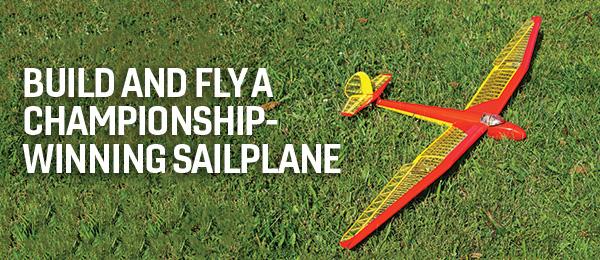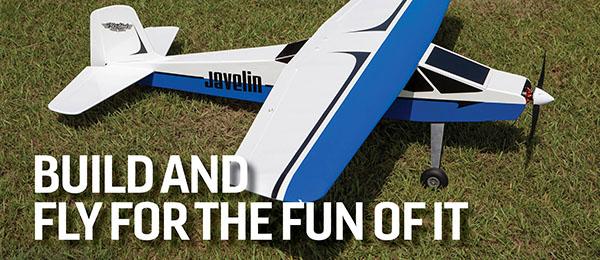Written by Paul Kohlmann
Part 2: Wing, motor pod, and maiden flight
As seen in the November 2020 issue of Model Aviation.
Download free plans!

Order Plans from AMA Plans Service





he theme of this second installment of the Volmer VJ-22 Sportsman build is perseverance. In the most obvious sense, perseverance is needed to complete any scratch build. From start to finish, this project should take an average builder a month or two to complete. That can be stretched out when competing interests such as family and work need attention. Perseverance is what separates the projects that make it to maiden flight day from those that gather dust. Sometimes, though, another dose of perseverance is needed to get beyond the maiden flight. This will be the subject of the last half of this article.
Building the Wing
The wing construction is based on a sheeted forward section and main spars joined by shear webs. When assembled, these parts form a rigid D-box. Start by shimming the lower 1/8 × 3/16-inch main spar with scrap 1/16-inch balsa then pinning the spar to the building board. Shimming in this way allows the spar to sit deeper into the rib notch so that the sheeting won’t stick up higher than the back half of the ribs. Shim rear spar RS and aileron leading edge (LE) A1 with 3/32-inch scrap in the same way. Now glue all of the ribs into place. They should stand perpendicular to the board except for the root rib. Tilt this one toward the wingtip by using the angle guide on the plans. This will set the dihedral when the wing halves are joined. After adding the upper main spar and shear webs S1 to S4, prepare the LE and trailing edge (TE) parts. Shaped balsa stock was used on the prototypes. After marking these parts against the plans, notches were cut into each of them for the ribs. A razor saw or a scroll saw makes quick work of this. Glue these parts into place. Complete the aileron by gluing in the riblets. Epoxy the plywood top motor pads in place. Make sure that the pads are in the proper orientations. The position and shape of the holes will determine the angles of the struts that hold up the motor pod. Align the wingtip panel to the underside of rear spar RS and rib W5 and glue it into place. Now the upper LE can be sheeted with 1/16-inch balsa. Unpin the wing and epoxy the lower motor pads and float pads in place. Add the bottom sheeting. After some sanding, the wing halves are ready to be joined.
Building the Wing Floats
The wing floats begin with 1/2-inch soft balsa pads at the top and the bottom. Shape the top of the upper pads so that they fit flush with the lower wing surface. The easiest way to do this is to cover the underside of the wing center section with 60-grit sandpaper. Sand the top of each pad side to side against the wing’s underside until the pad is contoured to fit the wing’s sheeting. Next, connect the upper and lower pads with 1/8-inch carbon-fiber rods. Leave the upper rod ends exposed so that they can later plug into the float mounting plates in the wing. Sheet the floats with 1/16-inch balsa. After sheeting, trim the bottom of the float as shown on the plans so that it will lift the wing from the water as speed increases. Seal the floats to make them watertight. A little fiberglass on their bottoms is also a good idea.






Building the Motor Pod
The Sportsman’s motor pod is a box that sits on four carbon-fiber struts. Although simple in design, the exact placement of the holes and notches in the assembly will define the motor thrust angles and the geometry of the pod to the wing, if assembled as planned. Start by attaching the little formers to the outsides of right-side former M3 and left-side former M4. These will be used later when the top of the pod is sheeted. Epoxy firewall M2 between formers M3 and M4. When properly assembled, the model will have 2° of right thrust. Epoxy this assembly to plywood plate M1. Attach a former M5 to the outer edge of M1 on each side. Now sheet between M5 and the little former on each side and between M3 and M4 with 1/16-inch balsa. The result will be a central motor housing flanked by a scoop on either side. Cut the four 5 mm carbon-fiber struts to length and dry-fit them. If necessary, massage the holes in the wing and/or the pod with a small rat-tail file until the pod angles match the plans.

At a Glance

50 inches Length: 32 inches Wing area: 178.8 square inches Wing loading: 23.76 ounces per square foot Flying weight: 29.5 ounces Power: L2210A 1,650 Kv motor; 3S 2,200 mAh LiPo battery; APC 7 × 6 propeller


Finishing the Assembly
In the spirit of tradition, I opted to use dowels and rubber bands as the wing attachment mechanism. Honestly, I like screws better, and that would be an easy modification, but the rubber bands have a certain old-fashioned appeal. I ran a 1/4-inch dowel through the fuselage in front of and behind the wing as shown on the plans. A scrap strip of 3/32-inch square balsa was epoxied between each dowel and the adjacent former to transfer the load away from the sheeting. Drill a 1/8-inch hole into the root wing ribs for a wing pin. Drill a matching hole in former F4 to receive the pin. Reinforce the area behind F4 with wood scrap. Epoxy a bit of wooden dowel into the wing hole. Fasten the wing in place with four size 33 rubber bands. Stretch one rubber band on each side of the pod and run the other two diagonally between the dowels. Close any openings left in the top sheeting, and the framework is complete.
The Maiden Flight
As maiden flights go, my expectations for the little Sportsman were basic. The model has a simple wing with low wing loading, and there was nothing unusual about the design. But through no fault of the model, a successful flight was a long time coming.
Attempt Number One
Sometimes accidents just happen. After losing our club pond, the first attempt was flown off of the club runway. The model had enough power to scoot along the AstroTurf, and it seemed that flight was upon us—until a raised nailhead brought things to an abrupt stop. After flipping upside down, a ragged gash in the hull revealed that the forward formers were shattered and the battery tray was loose. Although disappointing, sometimes accidents do happen. The odds of hitting a raised nailhead in our 400-foot runway were low, but when fate strikes, the odds feel like 100%. The best that can be done is to pick up the pieces and try again another day.
Attempt Number Two
Pride goeth before a fall. A record wet winter delayed the next attempt, but in its wake, flying sites for the Sportsman had popped up everywhere. The Sportsman was introduced to a nearby seasonal flood plain, where it took to water like a proverbial duck. Water handling was excellent, and the flying conditions were ideal. As throttle was increased, the Sportsman gathered speed with purpose and lifted cleanly. The climbout was steady, and all went according to plan as a bank to the left began. It made several fast circuits, along with a little trimming, but everything seemed okay until the power was reduced. The Sportsman instantly pitched up to the vertical, stalled, and then dropped straight toward the water. Could that have really happened? The Sportsman was easily recovered, so I tried that maneuver again. As before, as soon as power was removed, the previously docile aircraft stopped in its tracks then tipstalled. That left me in a quandary as I contemplated what a high-speed water landing of an unfamiliar aircraft was going to look like. I needn’t have worried. A few minutes later, a wisp of smoke exited the aircraft and it was no longer responsive. After several shallow, unpowered corkscrews, the Sportsman settled on the surface of the water like a feather. The trek through the chest-deep, 50° water was stimulating. A post-mortem revealed two ego-checking errors plus a new discovery. 1. I failed to properly measure the center of gravity (CG). Although this should have been simple on a rectangular wing, I was careless and didn’t pay attention. 2. The hull leaked. Although I checked for leaks before the hull was damaged on the first maiden flight attempt, I didn’t check my work after the repairs. The water leak exacerbated the tail-heavy CG condition and eventually wetted the ESC, resulting in its failure. Overconfidence in my repair skills created this problem. 3. The windmilling propeller created a great deal of drag high above the CG. A fellow builder explained this to me after having a similar experience with a different model. It turns out that turning the propeller brake on significantly reduces this drag as well as the pitch up. This was a learning experience for me. I would have thought that the windmilling propeller presented less drag than a stationary propeller, but that is not the case. By the way, a stationary propeller and a feathered propeller are not the same thing.

Attempt Number Three
The third time is the charm. More than a year went by before the Sportsman made it back onto my workbench. By that time, the sting of failure was gone, but the lessons learned were still fresh. They were written on a Post-it note that was stuffed inside the fuselage. After replacing the damaged electronics, sealing the hull properly, and correctly adjusting the CG, the Sportsman took a trip to Lake Sonoma in Geyserville, California. As before, the water handling was very good and a check showed that the water was staying on the outside of the hull. After lining up into the wind, the Sportsman gamely jumped off the water and gently banked into the first circuit. Some minor trimming followed, and then it was time for the moment of truth. While passing high above, I cut the throttle to zero. The Sportsman rose gently up by approximately 1 foot but continued onward. I later added a little upthrust to remove this tendency. The rest of the outing was completely routine. Takeoffs were clean, with the sturdy floats helping to pop the fuselage out of the water. Dead-stick landings tended to bounce, but adding a little power resulted in some nice, long touchdowns. The high wing configuration is better for patrolling the lake than for an aerobatic display, but the Sportsman can handle basic loops, wingovers, and Cuban 8s. This project is now in the win column. The downloadable plans incorporate the lessons that I learned along the way. The goals of being simple, durable, and fun were achieved, and some unexpected challenges were thrown in. All it took was a little perseverance!












Comments
Broken plans link
Good looking plane. Plans links are broken.
links fixed
Thanks for the tip.
volmer
here is a real volmer!
https://youtu.be/3KvSD3mij7M
Add new comment